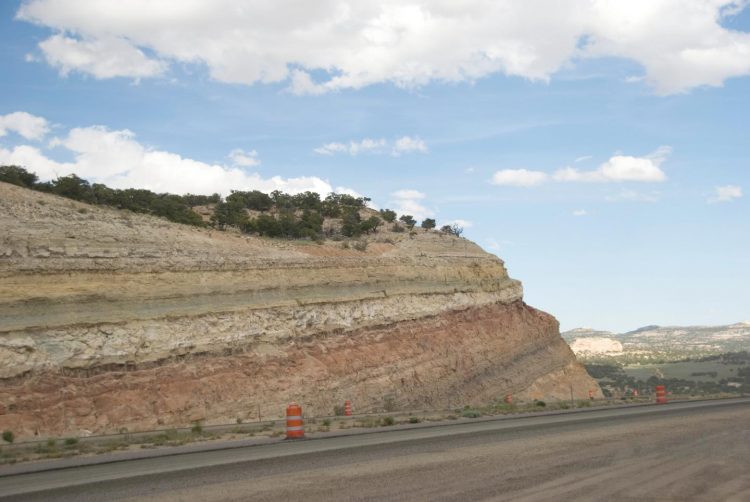Keep a lid on it: Utah State University geologists probe geological carbon storage

An outcrop of the Carmel Formation near Interstate-70 in the San Rafael Swell in southeastern Utah, USA. Utah State University geologists, with collaborators from Cambridge University, Shell Global Solutions, Tennessee's Oak Ridge National Laboratory and Germany's Jülich Center for Neutron Science, probed the Carmel caprock to assess the feasibility of effective carbon capture and storage (CCS) in underground reservoirs. Credit: Elizabeth Petrie, Western State Colorado University, USA.
Effective carbon capture and storage or “CCS” in underground reservoirs is one possible way to meet ambitious climate change targets demanded by countries and international partnerships around the world. But are current technologies up to the task of securely and safely corralling buoyant carbon dioxide (CO2) for at least 10,000 years – the minimum time period required of most agreements?
Across the globe, several pilot projects exist for CCS , the process by which CO2 emissions are collected and injected into underground reservoirs, but upscaling and demonstrating the process will work over the long term is a topic of active research.
“Nature may provide some answers,” says Utah State University geologist Jim Evans, who, along USU alum Elizabeth Petrie, currently of Western State Colorado University, students and colleagues, participated in an international research project, led by England's Cambridge University and Shell Global Solutions, aimed at assessing geological formations able to effectively contain carbon dioxide emissions.
The team published findings in the July 28, 2016, edition of 'Nature Communications.' The USU researchers' participation in the study, funded by Royal Dutch Shell, was also supported by a U.S. Department of Energy Basic Energy Sciences Grant.
“Storing carbon dioxide underground is a challenge because CO2 is less dense than water, exerts upward pressure, corrodes surrounding rocks and escapes,” says Evans, a professor in USU's Department of Geology. “Yet, natural carbon dioxide sequestration occurs and, with the study, we set out to discover the characteristics of areas where secure storage is possible.”
For several years, the team's research has focused on an area of southeastern Utah, where Evans says a natural laboratory exists to study the long-term interactions between CO2, water and rocks. Located near a fault, the site's natural and human-caused CO2 emissions can be studied from a minute to 400,000-year timescales. The current paper examines the result of a scientific drill hole in the area's Carmel Formation, a sandstone caprock about five miles south of Green River, Utah.
“The Carmel caprock features sandstone and fine siltstones overlying an aquifer naturally charged with carbon dioxide,” Evans says. “Our collaborators from Tennessee's Oak Ridge National Laboratory and Germany's Jülich Center for Neutron Science analyzed reservoir fluids from the drill hole, along with continuous drill core, using neutron scattering to determine the variations in the chemistry of the rocks.”
Evans and Petrie helped to design the coordinate the drilling and students from USU participated in the coring and water sampling.
“Water samples were obtained from depth, and this sampling was tricky,” Evans says.
Shell's Niko Kampman, the paper's lead author, used a device lowered in the drilling hole to capture the water and dissolved CO2 and keep it at pressure until samples could be analyzed in laboratories in Europe.
“Coring and sampling rocks and fluids, while a natural pressure is pushing everything upwards into the hole, is very challenging,” Evans says. “But the team was ultimately successful.”
The team then used computer modeling of the chemistry measured in the water, gas and rock to determine the naturally altered caprock's effectiveness in trapping carbon dioxide. They found it provided a barrier-forming zone in which minerals dissolve, react with carbon dioxide and precipitate and clog pores.
“These geochemical reactions occur at the nanopore level and create a very tight seal and, at the study site, retained carbon dioxide much longer than expected,” Evans says. “Our findings reveal important insights about the feasibility of storing carbon. Our work suggests that in natural systems, the CO2 may move very slowly in rocks and that effective seals are possible in some CCS scenarios.”
Media Contact
All latest news from the category: Earth Sciences
Earth Sciences (also referred to as Geosciences), which deals with basic issues surrounding our planet, plays a vital role in the area of energy and raw materials supply.
Earth Sciences comprises subjects such as geology, geography, geological informatics, paleontology, mineralogy, petrography, crystallography, geophysics, geodesy, glaciology, cartography, photogrammetry, meteorology and seismology, early-warning systems, earthquake research and polar research.
Newest articles

NASA: Mystery of life’s handedness deepens
The mystery of why life uses molecules with specific orientations has deepened with a NASA-funded discovery that RNA — a key molecule thought to have potentially held the instructions for…

What are the effects of historic lithium mining on water quality?
Study reveals low levels of common contaminants but high levels of other elements in waters associated with an abandoned lithium mine. Lithium ore and mining waste from a historic lithium…

Quantum-inspired design boosts efficiency of heat-to-electricity conversion
Rice engineers take unconventional route to improving thermophotovoltaic systems. Researchers at Rice University have found a new way to improve a key element of thermophotovoltaic (TPV) systems, which convert heat…



